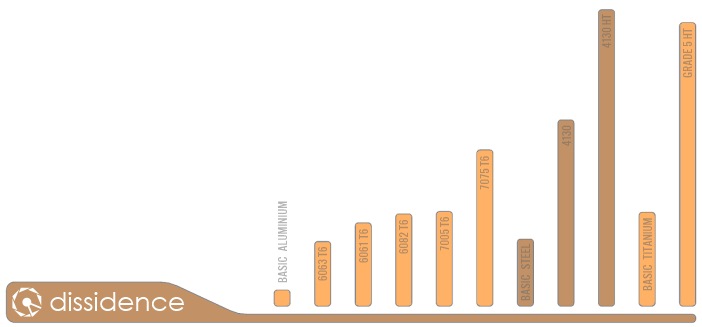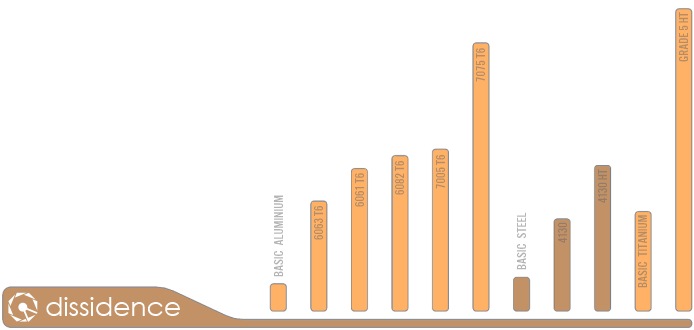General:
Even though two scooters can look identical, they can have a totally different quality. Everything depends on the production quality, materials used, post-treatments, etc.
These aspects are almost invisible on the finished product that you’ll have in your hands, but they can totally change the quality of the product.
Obviously from one case to another, the price can be tripled. Most entry-level brands that are not on our shop really work on giving a good image to their parts, instead of working on their technical features that will determine the product’s resistance and quality.
Here’s why it can be interesting to look at different materials’ technical properties, so you really know what you are buying.
Introduction to Metals:
Plastic and PU would take far too much time to sort by quality and there as so many variables. What interest us on a scooter are the metals – Aluminium, Steel, and Titanium are the most used metals.
Each one of these materials has their own advantages and disadvantages. Some are lighter but more fragile, other are really solid but weigh a lot more. The more fragile the material is, the more of it you will need to make it solid enough. Generally, the ‘resistance to weight’ ratios of these three elements are pretty much equal.
To sum it up simply, we are going to go over the main technical characteristics of these different materials. Obviously in reality, things are much more complicated and you would need to do a lot of research to truly understand every possible aspect of these materials.
Aluminium:
Aluminium is the lightest among the three, with a density ranging from 2.7 to 2.8 g/cm3, but it’s also the most fragile.
The big advantage is that it is fairly simple to manufacture, and it’s very cheap to make a mold, so you can easily create complex shapes. It’s a material that can also be forged, which makes the components made from this element even more resistant.
However, aluminium is very rigid, and after welding it requires heat-treating so the welding doesn’t break.
There are different alloys of aluminium. Indeed, aluminium is very fragile, including 1050 Alu with an elasticity of less than 60 MPa.
To make it more solid, aluminium is mixed with other chemical elements to make aluminium alloys which much more resistant than pure aluminium:
?2xxx = aluminium + copper
3xxx= aluminium + manganese
4xxx= aluminium + silicon
?5xxx= aluminium + magnesium
6xxx= aluminium + magnesium + silicon
7xxx= aluminium + zinc
?8xxx= aluminium + other elements
Beyond that, other small elements need to be added in order to produce the final aluminium. Depending on the proportions of these elements, the alloy name changes. Different alloys include 6061, 6082, and 7075, all commonly used in bars, decks, clamps, forks and pegs.
In scootering, the only alloys of any use are from the 6XXX and 7XXX series. This is not only due to their resistance, but also since they can be heat-treated.
Heat-treatment is a bit like ‘cooking’ the metal for a specific amount of time, at a very precise temperature. It makes the internal forces and welds homogeneous (meaning ‘of a uniform structure,’) to prevent them from breaking. It will give the material twice the resistance it had previously.
For 6XXX aluminium, the part is processed in the first oven for 2 hours then plunged in a liquid bath to cool it directly. This is called T4 treatment. After such a treatment, the part can sometimes moves out of place and need to be straightened, meaning that head-tube intended to be 82.5° could actually turn out as 80° once cooled.)
Then, the part is re-heated for roughly 8 hours at a lower temperature, and left to cool slowly: this is known as T6 treatment.
For 7005, the process is very different. Heat treatment is a very precise process, and needs to be done with great accuracy; else the theoretical resistance desired will not be reached.
Alloys properties:
6063 T6: 240 MPa
This is the entry-level aluminium of the 6XXX series, often used on entry-level scooters. Most of the time, it’s not specified in the products’ description, simply because it’s a cheap alloy.
The first District decks (v.1) were made out of this alloy and broke after about a week of riding. The following versions stepped up to 6061, and the difference was clear.
6061 T6: 310 MPa
This is the most used aluminium on premium scooters, but it’s still an economic material.
6082 T6: 340 MPa
The best alloy of the 6XXX series.
7005 T6: 350 MPa
It is the only aluminium from the 7XXX series which can be welded. Its characteristics are pretty similar to that of 6082.
7075 T6: 580 MPa
This is the ‘Rolls Royce’ of aluminiums, 3 times more expensive than 6061. It is very difficult to machine or forge because of its very high density. It’s also impossible to extrude or to weld 7075 aluminium.
You will never see a deck or a bar made from 7075 aluminium. Any claims of such parts will not be genuine.
7075 aluminium parts need to be made with the use of a CNC machine, hence why you can only find forks or pegs using this material.
Some brands will simply lie about the alloy they are using. Sometimes it’s even the factory that lies to the brand about the aluminium they supply. Remember, all it takes is money for the Chinese businessman to hand over a certificate of authentication which can then be used as ‘proof.’ This is exactly why rider-owned brands are better, because they really work to make better products, and they make sure that everything is legitimate.
Steel:
Steel is much harder to machine than aluminium, it’s also almost impossible to extrude, except for simple shapes such as cylinders. Despite this, the material itself is cheaper than aluminium.
It’s also much heavier than aluminium with a density of 9.8 g/cm. However, used with less volume than aluminium, the final component can have almost the same weight.
In BMX, steel replaced aluminium a long time ago due to its flexible properties that aluminium doesn’t possess. This flexibility allows it to handle violent shocks way better than its rival metals.
Steel doesn’t require heat treatment like aluminium, but doing so can increase its resistance by up to 40%. However, the process is different from aluminium and more expensive to do.
Initially, steel has a resistance of 250 MPa, but depending on the properties of its alloys, it can be much higher.
The most common alloy is 4130 Chromoly, also referred to as 25CD4 in Europe. It’s an alloy consisting of steel, iron and carbon with 1% of chrome (Cr) and 1% of molybdenum (Mo).
Its resistance is roughly 700 MPa, and after heat treatment it can go up to 1100 MPa, but only on very high end tubes that we will probably never see on freestyle scooters.
Titanium:
The main characteristic of titanium is its elasticity. Almost double that of steel, and 8 times more than aluminium.
Titanium is not more solid than steel, it’s just slightly less, but it can be higher in certain cases, with the right treatments. It’s also very light, with a density of 4.5 g/cm3.
In terms of weight, it is heavier than aluminium, but only half the weight of steel, although it has almost the same resistance. It allows us to use higher volumes than we would with steel, but still lighter and more resistant.
The problem with titanium is that it’s very expensive. It’s hard to find and just as hard to machine.
Like aluminium and steel, there are different alloys of titanium, sorted into grades depending on their properties. There are 38 different grades.
Raw titanium has a resistance of 350 MPa.
Grade 5 titanium, also referred to as 6AL-4V, is the most used in aeronautics and aerospace, and the one that you will find the most in machined titanium components of any kind. Its resistance can reach 1050 MPa after a heat treatment.
This alloy can also be welded and heat-treated.
We really hope to see more and more titanium parts, maybe even a deck, but your wallets sure won’t!

Resistance recap

Ratio weight / resistance